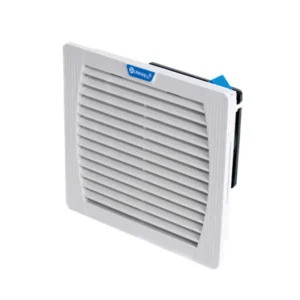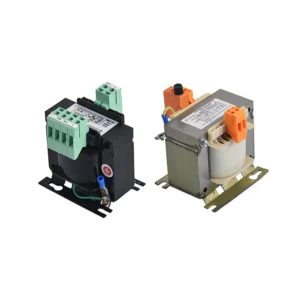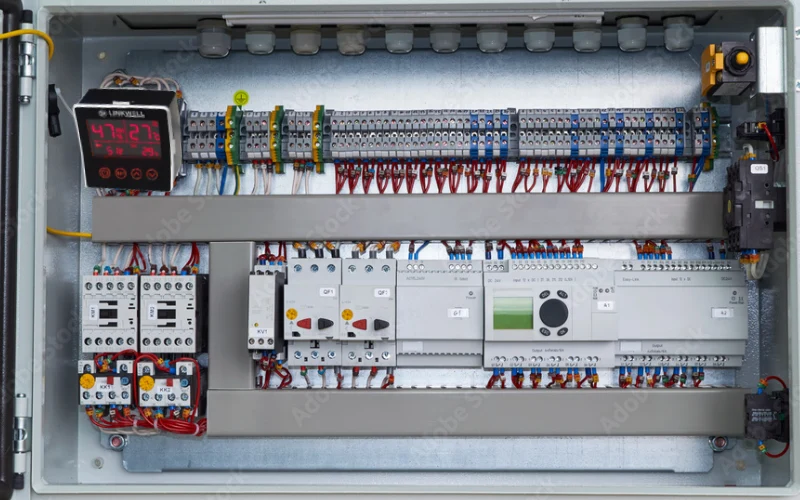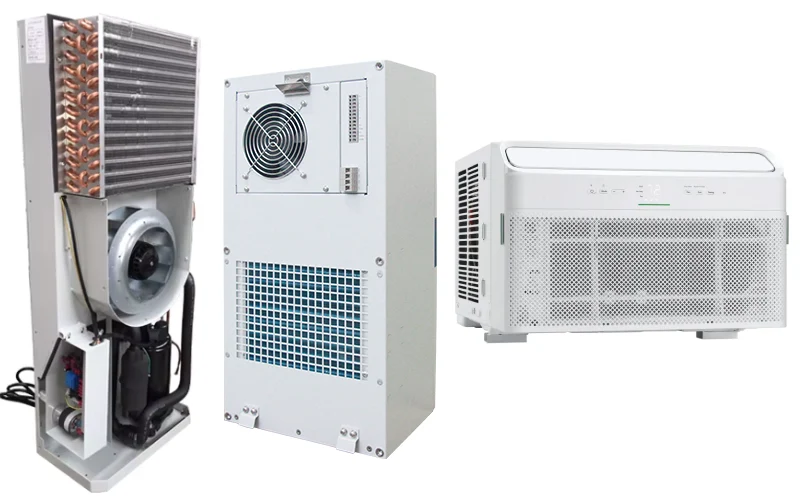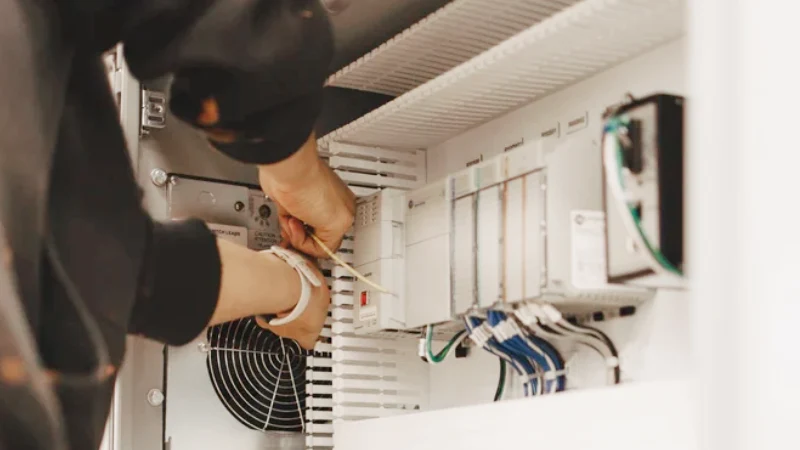You want to know what is needed for industrial control panels in 2025? Start by focusing on project requirements and making sure your specifications match the latest standards for electrical equipment. When creating control panels, you need key elements like breakers, power distribution, terminal blocks, transformers, and wire ducts.
Safety and compliance matter more than ever. Linkwell’s certified solutions set the bar for reliability and innovation, helping you meet every challenge with confidence.
Key Takeaways
- Focus on key components like breakers, transformers, and relays to ensure safety and reliability in your control panels.
- Stay updated with the latest standards and certifications, such as UL and IEC, to avoid costly mistakes and ensure compliance.
- Implement smart monitoring and automation features to enhance efficiency and reduce downtime in your operations.
- Choose energy-efficient solutions to lower costs and meet sustainability goals while maintaining high performance.
- Regularly inspect and maintain your control panels to catch issues early and keep your systems running smoothly.
What is Needed for Industrial Control Panels
Key Components
When you start planning an industrial control panel, you need to know what is needed for industrial control panels to meet modern requirements. The right components make your system safe, reliable, and ready for the future. Here’s a quick look at the most important electrical components and their main functions:
| Component | Function |
|---|---|
| Circuit Breakers | Protect circuits from overloads and short circuits. |
| Fuses | Provide overcurrent protection by breaking the circuit if needed. |
| Relays | Act as switches for automation and control. |
| Contactors | Control motors and high-power devices. |
| Transformers | Adjust voltage levels for different uses. |
| Power Supplies | Deliver the right amount of power to your equipment. |
| PLCs | Control automated processes and respond to sensor input. |
| Motor Drives | Manage motor speed and performance. |
| Terminal Blocks | Connect and organize wires safely. |
| Switches | Open or close circuits for control. |
| Indicators | Show equipment status with lights or signals. |
| Ethernet Switches | Enable communication between devices. |
| Sensors | Detect changes in temperature, pressure, or motion. |
| Cooling System | fan,Cabinet Air Conditioner. Keep the panel at a safe temperature. |
| Cable Management | Organize and protect wiring for safety and airflow. |
You can see that these components work together to keep your industrial control panel running smoothly. Linkwell’s electrical control panel stands out because it brings all these elements together in a certified, customizable package. Their panels use high-quality electrical components, including circuit breakers, relays, and terminal blocks, to meet strict requirements for safety and performance. You get a solution that is ready for both new installations and upgrades.
Recommended products
Power Distribution
Power distribution is at the heart of every industrial control panel. You need to make sure that power flows safely and efficiently to every part of your system. The right power distribution components protect your equipment and help you avoid costly downtime. Here’s what is needed for industrial control panels when it comes to distribution:
- Use certified electrical power distribution boxes to split power into different circuits.
- Choose components with high IP ratings for harsh or outdoor environments.
- Make sure your distribution setup includes clear labeling and easy access for maintenance.
Linkwell’s electrical power distribution box meets global standards like UL and IEC. You get a box that is easy to install, customizable, and built to last. Their solutions help you organize your electrical components and improve system reliability. When you use the right power distribution, you reduce risks and keep your operations running smoothly.
Many leading companies have improved their systems by upgrading their power distribution. For example, a European utility used panels with IoT sensors and cut maintenance costs by 15%. A North American plant switched to new panels and saw better energy efficiency and compliance. These stories show how smart power distribution can make a real difference.
Control Devices
Control devices are the brains and nerves of your industrial control panel. You need reliable devices to automate processes, monitor equipment, and keep everything running as planned. Here’s what is needed for industrial control panels in 2025 when it comes to control devices:
| Control Device | Advantages |
|---|---|
| Contactors and Relays | Enable automation and reliable switching for equipment. |
| Programmable Logic Controllers (PLCs) | Handle complex tasks and adapt to changing needs. |
| Human Machine Interfaces (HMIs) | Let operators interact with the system and monitor status remotely. |
| Motor Starters and Drives | Control motors for better efficiency and less wear. |
| Sensors and Input Devices | Detect process changes and allow manual control when needed. |
You want control devices that are easy to program, flexible, and ready for future upgrades. Linkwell’s electrical control panel includes advanced PLCs, relays, and HMIs that support automation and remote monitoring. Their control transformer delivers stable voltage for sensitive circuits, meeting UL, CE, and ISO9001 standards. You get a dependable setup that meets the requirements of modern industry.
If you want to know what is needed for industrial control panels to stay ahead, look for components that support IoT, predictive maintenance, and real-time diagnostics. Manufacturers now offer more customization, energy-efficient designs, and smart monitoring features. Here’s a quick table of the latest trends:
| Trend | Description |
|---|---|
| IoT-enabled components | Enhanced connectivity for better data and control. |
| Predictive maintenance | Components that help you spot problems before they cause downtime. |
| Real-time diagnostics | Instant feedback for faster troubleshooting. |
| Energy efficiency and sustainability | Lower energy use and greener manufacturing. |
| Customization options | Tailored solutions for your unique needs. |
| Adaptation of pricing strategies | Flexible pricing, including subscriptions and leasing. |
When you choose Linkwell’s electrical control panel, control transformer, and power distribution box, you get certified, reliable, and future-ready solutions. These products meet the requirements for safety, efficiency, and smart automation. You can trust them to deliver what is needed for industrial control panels in 2025 and beyond.
Design and Compliance
Standards and Certifications
When you think about control panel design in 2025, you can’t ignore the importance of standards. These rules shape every part of your project, from the first sketch to the final inspection. You want your control panel design to meet the latest UL, IEC, and CE standards. These standards keep your equipment safe and reliable, and they help you avoid costly mistakes.
| Standard | Description |
|---|---|
| UL 508A | Industrial Control Panels |
| UL 698A | Industrial Control Panels for Hazardous Locations |
| IEC 61439 | Low-voltage Switchgear and Controlgear Assemblies |
| CE Marking | European Conformity for Electrical Equipment |
You’ll notice that these standards affect your control panel design choices. For example, the 2025 updates to UL 508A mean you need to select components and document your work more carefully. If you want to keep up with changing standards, you have to stay informed and adjust your design process as needed. Linkwell leads the way here, with products that carry UL, CE, and TUV certifications. Their commitment to compliance means you get control panel design solutions that are ready for any market.
Safety Features
Safety sits at the heart of every good control panel design. You want to protect your team and your equipment, so you need to build in the right features. Emergency stop buttons, fault alarms, and ground fault protection all help reduce risks. Advanced fail-safe systems and hazard monitoring give you extra layers of protection.
OSHA requires clear lockout/tagout procedures. Make sure your control panels have labeled disconnects and secure lockout points to keep everyone safe during maintenance.
Proper documentation and labeling make a big difference. Use color-coded labels for wires and circuits. Place labels where they’re easy to see, especially at junctions and terminations. Durable, fade-resistant materials help your labels last. Regular audits keep your system up to date.
Here are a few tips for better safety and compliance in your control panel design:
- Choose components that meet the latest standards.
- Use proper grounding to prevent electrical hazards.
- Mark every circuit for its purpose and maximum fault current.
- Keep your documentation organized and easy to access.
When you follow these steps, you create a control panel design that meets industry standards and keeps your workplace safe.
Enclosure and Environmental Protection
Enclosure Types
Choosing the right enclosure is a big deal for your industrial control panels. You want to keep your equipment safe from dust, water, and accidental bumps. Different enclosure types offer different levels of protection and flexibility. Here’s a quick table to help you see what’s out there:
| Enclosure Type | Description |
|---|---|
| NEMA 1 | General-purpose, keeps you from touching live parts. |
| NEMA 4 | Blocks dust, rain, and water jets—great for tough jobs. |
| Stainless Steel Enclosures | Handles harsh, corrosive environments with ease. |
| Wall-Mounted Enclosures | Perfect for indoor use and smaller systems. |
| Free-standing Enclosures | Works well for bigger setups that need flexibility. |
| Modular Enclosures | Lets you expand or change things as your needs grow. |
Material choice matters, too. Stainless steel 316 stands up to corrosion and lasts longer in rough conditions. Some enclosures use a special finish to boost durability. If you want your control panel to survive in extreme places, pay attention to hinges, latches, gaskets, and climate control. These details help prevent damage and keep your system running.
Cooling Solutions
Heat is the enemy of electronics. If your control panel gets too hot, things can break down fast. That’s why you need smart cooling solutions. Panel coolers and heat exchangers are popular in 2025. They use forced air or special fluids to move heat away from sensitive parts. You’ll find these coolers in factories, power plants, and telecom sites.
Linkwell’s Cabinet Air Conditioner and ventilation systems make a real difference. Their fans move air efficiently, keeping temperatures steady and reducing condensation. If you keep your cabinet below 40°C (104°F), you double the life of your components. Linkwell’s systems also filter out dust and lower humidity, which means fewer breakdowns. Thermostats let you control when the cooling kicks in, so you save energy.
You can customize enclosures for outdoor or hazardous spots. Here are some options:
| Customization Option | Description |
|---|---|
| Compliance with NEMA & UL standards | Meets strict safety rules for risky environments. |
| Tailored design services | Get a control panel built for your exact needs. |
Some setups even come preassembled with push buttons, switches, and lights rated for hazardous areas. If you need something special, you can work with experts to design a solution that fits your site.
Tip: Always keep your enclosure at least 5°C warmer than the outside air to stop condensation and protect your equipment.
Wiring and Layout
Getting your wiring and layout right is key to building a control panel that works well and stays safe. You want everything organized, easy to access, and simple to maintain. Let’s break down the essentials.
Terminal Blocks
Terminal blocks make your life easier. They give you secure, insulated connections that help prevent short circuits and loose wires. You’ll find them made from tough materials like nickel-plated copper and nylon, so they last a long time and resist corrosion. Insulated barriers and clear covers keep you safe and make maintenance a breeze.
Here’s a quick look at the types you might use:
| Type | Main Use |
|---|---|
| Feed-thru | Connect two wires directly |
| Ground | Provide a safe grounded connection |
| Fused | Add overcurrent protection |
| Multi-level | Save space with stacked connections |
| Disconnect | Let you disconnect wires easily |
You should pick terminal blocks that match your system’s needs. Screw-type and push-in styles both offer reliable connections. Specialized blocks handle heat and flames, so you can use them in tough environments. Linkwell’s terminal blocks meet international safety standards and work well for global projects.
Tip: Always label your terminal blocks clearly. This helps you and your team find circuits fast and avoid mistakes.
Wiring Ducts
Wiring ducts keep your panel neat and tidy. They guide wires along set paths, which cuts down on clutter and makes troubleshooting much faster. When you use wiring ducts, you save space and reduce material costs because your wire runs are shorter and more efficient.
Here are some best practices for wiring arrangement and cable management:
- Standardize wire colors and labels for quick identification.
- Route wires carefully to avoid tangles and keep things organized.
- Bundle wires to improve airflow and reduce heat around sensitive electronics.
- Secure connections and use insulation to boost reliability.
- Keep grounding wires separate from power cables for safety.
- Follow NEC and IEC guidelines for logical routing and support.
Linkwell’s wiring ducts are built for easy installation and long-term durability. They help you create a panel layout that’s simple to maintain and upgrade.
Note: A well-organized panel not only looks professional but also makes repairs and upgrades much easier.
Future Trends
Automation and Smart Monitoring
You’re about to see big changes in industrial control panels. In 2025, automation is smarter than ever. AI and machine learning now play a huge role. These systems learn from real-time data and adjust how they work. You get better efficiency and less downtime. Adaptive control systems take things further. They change their settings on the fly, so your equipment always runs at its best—even when conditions shift.
Wireless technology is also making waves. You can now monitor your industrial control panels from anywhere. Remote access means you spot problems early and fix them fast. Edge computing lets your devices process data right where it’s collected. This means faster reactions and less data sent to the cloud. The market for smart industrial control panels keeps growing, with billions invested every year.
The Industrial Internet of Things (IIoT) is another game changer. Here’s what IIoT brings to your control panels:
- Real-time data access for smarter decisions
- Better monitoring and maintenance with live updates
- Easier ways to predict when equipment needs attention
Linkwell’s panels come with smart monitoring features. You can track performance, get alerts, and even schedule maintenance before something breaks. These automation components help you stay ahead of problems and keep your systems running smoothly.
Energy Efficiency
Energy efficiency is now a top priority for industrial control panels. Companies want to save power and cut costs. In 2025, almost half of new panels include IoT devices that help you monitor energy use and spot waste. AI-powered systems can predict when equipment needs service, so you avoid breakdowns and use less energy.
Many panels now have built-in energy-saving systems. These tools help you reach your sustainability goals and lower your bills. Linkwell offers energy-efficient solutions that make a real difference. Their products help you reduce downtime and improve productivity.
You’ll see more demand for panels that combine smart monitoring with energy management. This trend will only grow as more companies look for ways to run greener, more efficient operations.
Tip: Choose industrial control panels with advanced monitoring and automation features. You’ll save energy, reduce downtime, and keep your business ready for the future.
| Trend | Benefit |
|---|---|
| AI and Machine Learning | Smarter, adaptive control |
| IIoT Integration | Real-time data and remote monitoring |
| Edge Computing | Faster response and local processing |
| Energy-Saving Systems | Lower costs and greener operations |
You want your industrial control panels ready for 2025. Start by checking for outdated parts, weak cybersecurity, and reliability issues. Trusted brands like Linkwell help you with custom solutions and ongoing support.
Key steps for future-proofing:
- Follow safety standards.
- Leave space for upgrades.
- Plan power and cooling.
- Label and organize wiring.
- Use quality control.
- Assess risks.
- Add modern communication and security.
| Linkwell Support | What You Get |
|---|---|
| Warranty | One-year coverage for peace of mind |
| Technical Support | Lifetime help with any panel issues |
| Spare Parts | Fast replacement for failed components |
| Training Materials | Guides to keep your team informed |
| Installation Guidance | Help with wiring and setup |
| Troubleshooting | Quick solutions for operational problems |
| Priority Service | Faster service for distributors and OEMs |
Tip: Review your current panels now. Upgrade to meet new standards and explore smart, energy-saving technologies.
FAQ
What certifications should my industrial control panel have in 2025?
You should look for UL, IEC, and CE certifications. These show your panel meets safety and quality standards. Linkwell’s panels come with these certifications, so you know you’re getting reliable equipment.
How often should I inspect or maintain my control panel?
Check your panel every six months. Look for dust, loose wires, and signs of overheating. Regular inspections help you catch problems early and keep your system running smoothly.
Can I customize my control panel for harsh environments?
Absolutely! You can choose enclosures with high IP or NEMA ratings, add cooling systems, and pick corrosion-resistant materials. Linkwell offers custom solutions for tough conditions.
What’s the best way to organize wiring inside my panel?
Use labeled terminal blocks and wiring ducts. Keep wires neat and separated by function. This makes troubleshooting easier and keeps your panel safe.



